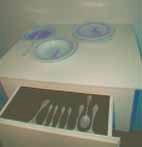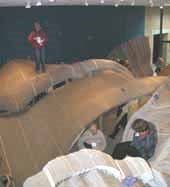25 October 2006
Another Houston Blog
An addition to our list of Blogs reporting on the 'Shaping the Future of Craft' conference. David Richardson leads Furniture Society - After Hours : thoughts and ideas related to studio furniture, craft, and art.
craft research
craft research
A remark by one of the delegates at the houston conference intrigued me. She was referring to Norman Kennedy a weaver/spinner origionally from Aberdeen, now living in the USA, http://www.nea.gov/honors/heritage/Heritage03/Kennedy.html and said, 'Of course he is a National Treasure now.' I wasn't aware that America, like Japan, had living 'National Treasures'. Isn't it wonderful that a Scottish Craftsperson is an American National Treasure!
"Japan’s living national treasuresScholars have long recognized the intangibility of culture. In the 18th and 19th centuries philologists, folklorists and others tried to document the world’s oral traditions. Yet the term “intangible cultural heritage” is relatively recent. In 1950, Japan initiated a living national treasures programme to recognize the great skills of masters of the traditional arts.Similar programmes began in Korea, the Philippines, Thailand, the United States and France. Intangible heritage is seen as an asset or resource to be protected, appreciated, utilized and managed–an idea traceable back to the Meiji period". http://www.unesco.org/courier/2001_09/uk/culture.htm
Does the UK honour people like this? Especially in the area of 'great skill in the traditional arts'? One would presume that craftspeople would be among these honoured people???
A remark by one of the delegates at the houston conference intrigued me. She was referring to Norman Kennedy a weaver/spinner origionally from Aberdeen, now living in the USA, http://www.nea.gov/honors/heritage/Heritage03/Kennedy.html and said, 'Of course he is a National Treasure now.' I wasn't aware that America, like Japan, had living 'National Treasures'. Isn't it wonderful that a Scottish Craftsperson is an American National Treasure!
"Japan’s living national treasuresScholars have long recognized the intangibility of culture. In the 18th and 19th centuries philologists, folklorists and others tried to document the world’s oral traditions. Yet the term “intangible cultural heritage” is relatively recent. In 1950, Japan initiated a living national treasures programme to recognize the great skills of masters of the traditional arts.Similar programmes began in Korea, the Philippines, Thailand, the United States and France. Intangible heritage is seen as an asset or resource to be protected, appreciated, utilized and managed–an idea traceable back to the Meiji period". http://www.unesco.org/courier/2001_09/uk/culture.htm
Does the UK honour people like this? Especially in the area of 'great skill in the traditional arts'? One would presume that craftspeople would be among these honoured people???
24 October 2006
Well Hallelujah!
I can't believe it! After posting comments yet to be 'approved' by blog owners, and attempting to get my comments actually ON the blog ... maybe this time it might actually work! Someone design a user friendly thing without such an ugly name! Anyway, rant over, lets see if this actually DOES publish my comment or whether mechanized monsters are actually out to get me, and it's not all in the mind!
Houston calling Dundee, Houston calling Dundee! Come in Dundee.Looking at the future of crafts. Well, it's not the future as we know it, that's for sure! It was very interresting to listen to the different accents and drawls, the nuances of differing local cultures between those in New York, San Fransisco, and far off exotic places (for us) The ideas were just as different. The leaders in the craft world accross the Pond, are administrative - gallery owners, curators, collectors, sellors and historians of 'art', very few 'makers' and most of them had little to do with their practice now that they were involved in the business and political side of it all. Educators appeared to be the ones most likely to be involved in practice. Where was the craft? Well, in the galleries were examples of well known 'artists' of craft or was it craftsters, or artists using craft as a medium, or craftspersons (dirty word) doing craft art? Terminology was bantered to and fro between intellectualized rhetoric which was a mirror - so it seemed - of the craft world. Crafts appears to be devided into the 'hobbyists' the 'DIYists' and 'homecrafters' none of which had their work underpinned by intellectual rigour. Jump the great divide and you find yourself among those who do not want to be craftspersons, but are all referred to as 'artists'. It appears that if you do any form of art; be it electronic based, craft based, paint based, installation based or anything else that demonstrated intellectual rigiour, you are an artist - no longer a craftsperson. Is this the way forward? To revert to the age old terminology, ie art being all encompassing and therefore artist being the executor of the personal vision through whatever medium he/she wishes at the time? Could that be retrogressive or progressive? There were no answere. Many questions, some timid ones from practitioners and students right at the end - but no answer.The networking, contacts, laughter, penetrationg discussions, and comments over meals were probably the most important aspect of the conference. There was much to think about! Many email contacts to be maintained, and sleep to be caught up on.Houston signing out Nanu, nanu!
Houston calling Dundee, Houston calling Dundee! Come in Dundee.Looking at the future of crafts. Well, it's not the future as we know it, that's for sure! It was very interresting to listen to the different accents and drawls, the nuances of differing local cultures between those in New York, San Fransisco, and far off exotic places (for us) The ideas were just as different. The leaders in the craft world accross the Pond, are administrative - gallery owners, curators, collectors, sellors and historians of 'art', very few 'makers' and most of them had little to do with their practice now that they were involved in the business and political side of it all. Educators appeared to be the ones most likely to be involved in practice. Where was the craft? Well, in the galleries were examples of well known 'artists' of craft or was it craftsters, or artists using craft as a medium, or craftspersons (dirty word) doing craft art? Terminology was bantered to and fro between intellectualized rhetoric which was a mirror - so it seemed - of the craft world. Crafts appears to be devided into the 'hobbyists' the 'DIYists' and 'homecrafters' none of which had their work underpinned by intellectual rigour. Jump the great divide and you find yourself among those who do not want to be craftspersons, but are all referred to as 'artists'. It appears that if you do any form of art; be it electronic based, craft based, paint based, installation based or anything else that demonstrated intellectual rigiour, you are an artist - no longer a craftsperson. Is this the way forward? To revert to the age old terminology, ie art being all encompassing and therefore artist being the executor of the personal vision through whatever medium he/she wishes at the time? Could that be retrogressive or progressive? There were no answere. Many questions, some timid ones from practitioners and students right at the end - but no answer.The networking, contacts, laughter, penetrationg discussions, and comments over meals were probably the most important aspect of the conference. There was much to think about! Many email contacts to be maintained, and sleep to be caught up on.Houston signing out Nanu, nanu!
22 October 2006
Shaping the Future of Craft - Day Two (am)
 This second day in Houston started with an examination of critical writing in craft and began with a tour de force from Glen Adamson
This second day in Houston started with an examination of critical writing in craft and began with a tour de force from Glen Adamson(V &A) and Edward S Cooke (Yale) in a 'master and apprentice' two hander covering craft history from the 1950's. The pair examined four periods; 1950's, 1960's, 1980 - 2000 and the present in an inner and outer dialectical approach. In this historical overview it was clear that craft has lacked any political or broader social awareness in much of the work that has been produced which in part is being remedyied in some contemporary work for example a recent exhibit which displayed fine silverware juxtaposed with slave shackles under the title metalwork! The focus in the now and in the future was on crafts engagement with the discourse.
The main suggestion was that craft should be grounded in the discourse. What do we think about this? I personally feel that what is unique about craft is that it has been grounded in its materials and holistic/organic way of seeing the world. If we expand this to include the discourse how does this affect craft as we know it? Most craft practitioners to date have been content to effectively ignore the discourse and concentrate on their relationship with their materials. Do the benefits of being engaged with the discourse outweigh the disadvantages?
We were encouraged to consider the stakes both economically and politically; think about the divergences with art and think about deeper integration. Simon Starlings Turner winning Shed Boat Shed was presented as an example of craft processes being used to trace embeddedness in the economy. If one word were to be used to sum up a vision of the future of craft it would be hybridisation. Craft techniques or processes being mixed with aspects of other disciplines to create something new. One speaker suggested that young artists are no longer married to their materials. What do we feel about this?
Much of the Q & A concentrated on the pedagogical implications of what had been heard and whether we should be aiming to build the person or build a society and what role the market should play in shaping craft education. It was further suggested that there is in fact a huge discourse surrounding the crafts but we prefer not to acknowledge it.
Speakers in subsequent sessions had a hard job following this act. A further session on critical writing followed with erudite contributions from Tanya Harrod, Maria Porges and Susan Yelavich. Tanya highlighted examples of craft as a form of critque where the work itself is taking more of a archeological than historicist turn. She cited an example of hand made ceramics in Stoke that effectively comments on Wedgewood who have relcoated their operations out of the UK on economic grounds. Her overarching message was that the economy will have an impact on the quality of the critical discourse. Another key theme emerging from the other speakers in this session was the increased reflexivity apparent in more recent work produced where craft has become interested in itself and student work has become much more self conscious. Ultimately contributors in this session felt that what was needed was a greater sense of our connection to the wider world and an awareness of the issues in the world.
20 October 2006
Houston blogs
In addition to Sandra (see below), there are others blogging from Houston:
Amy Shaw and Jae Kim are there and possibly blogging.
The ever-insightful Dennis Stevens is also blogging.
If I find more, I'll post them. To those there - enjoy.
Amy Shaw and Jae Kim are there and possibly blogging.
The ever-insightful Dennis Stevens is also blogging.
If I find more, I'll post them. To those there - enjoy.
19 October 2006
Shaping the Future of Craft
craft research
American Craft Council Conference
Houston Texas
Pre-conference Tour
A whistle stop tour of over eleven different museums and galleries in Houston enables you to develop a clear view of the state of contemporary craft particularly its curation and status. It was striking how differently craft was treated in each of these spaces.

First stop was the Hiram Butler Gallery and Darryl Lauster's "A Seat at the Table Exhibition (Left)". This in part paid homage to craft makers of the past by dipping early 20th century cuttlery and crockery in paint with iconic images e.g. statue of liberty etc. Here craft was appropriated as part of a language.
The Rice Gallery part of Rice University provides gallery space for contemporary artists to create innstallations on site. The current exhibition "Rip Curl Canyon" by designers Gaston Nogues and Benjamin Ball evokes "a mythical location in the American West where land and water collide" (Below). This is a
fan tastic installation where visitors are unusually for an art gallery encouraged to climb on and under and become part of the experience. Is this art or is this craft? Certainly on one level and particularly to a viewer it really doesnt matter. The question however is of relevance in economic and pedagogical terms. In this space less commercial work which is perhaps more challenging can be produced. One curator did abruptly suggest that the question was just pornography!
tastic installation where visitors are unusually for an art gallery encouraged to climb on and under and become part of the experience. Is this art or is this craft? Certainly on one level and particularly to a viewer it really doesnt matter. The question however is of relevance in economic and pedagogical terms. In this space less commercial work which is perhaps more challenging can be produced. One curator did abruptly suggest that the question was just pornography!
The Museum of Fine Art had a different approach to this question. In a rare move all the curators had worked together to jointly curate an exhibition on memory and here we were able to see craft objects, for example jewellery by Wendy Ramshaw sitting alongside painting and new media - all with equal status. This was refreshing and an approach that other museums should be encouraged to adopt.
Opening keynote speaker Sculptor Martin Puryear suggested that craft suffers from a semantic indeterminacy however it survives because of the deeper longing that we have to live with objects that provide a nourishing intimacy. He preferred the term artisan to craft. As appears to be custom at craft conferences these days Martin announced that he himself was not a craftsperson and was a little bewildered as to why he had been asked to speak! He effectively laid down the gauntlet however by reminding us that when critics suggested painting was dead - it was a call to pick up brushes and produce work of the highest quality. Certainly as some have suggested recently that "Craft is Dead" then perhaps similarly we should respond by producing some outstanding examples of craft that more clearly articulate what is so special and unique about the discipline.
American Craft Council Conference
Houston Texas
Pre-conference Tour
A whistle stop tour of over eleven different museums and galleries in Houston enables you to develop a clear view of the state of contemporary craft particularly its curation and status. It was striking how differently craft was treated in each of these spaces.

First stop was the Hiram Butler Gallery and Darryl Lauster's "A Seat at the Table Exhibition (Left)". This in part paid homage to craft makers of the past by dipping early 20th century cuttlery and crockery in paint with iconic images e.g. statue of liberty etc. Here craft was appropriated as part of a language.
The Rice Gallery part of Rice University provides gallery space for contemporary artists to create innstallations on site. The current exhibition "Rip Curl Canyon" by designers Gaston Nogues and Benjamin Ball evokes "a mythical location in the American West where land and water collide" (Below). This is a
fan
 tastic installation where visitors are unusually for an art gallery encouraged to climb on and under and become part of the experience. Is this art or is this craft? Certainly on one level and particularly to a viewer it really doesnt matter. The question however is of relevance in economic and pedagogical terms. In this space less commercial work which is perhaps more challenging can be produced. One curator did abruptly suggest that the question was just pornography!
tastic installation where visitors are unusually for an art gallery encouraged to climb on and under and become part of the experience. Is this art or is this craft? Certainly on one level and particularly to a viewer it really doesnt matter. The question however is of relevance in economic and pedagogical terms. In this space less commercial work which is perhaps more challenging can be produced. One curator did abruptly suggest that the question was just pornography!The Museum of Fine Art had a different approach to this question. In a rare move all the curators had worked together to jointly curate an exhibition on memory and here we were able to see craft objects, for example jewellery by Wendy Ramshaw sitting alongside painting and new media - all with equal status. This was refreshing and an approach that other museums should be encouraged to adopt.
Opening keynote speaker Sculptor Martin Puryear suggested that craft suffers from a semantic indeterminacy however it survives because of the deeper longing that we have to live with objects that provide a nourishing intimacy. He preferred the term artisan to craft. As appears to be custom at craft conferences these days Martin announced that he himself was not a craftsperson and was a little bewildered as to why he had been asked to speak! He effectively laid down the gauntlet however by reminding us that when critics suggested painting was dead - it was a call to pick up brushes and produce work of the highest quality. Certainly as some have suggested recently that "Craft is Dead" then perhaps similarly we should respond by producing some outstanding examples of craft that more clearly articulate what is so special and unique about the discipline.
Subscribe to:
Posts (Atom)